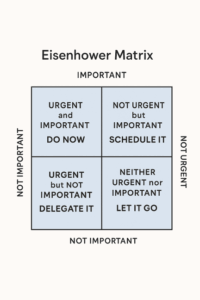What is important is seldom urgent, and what is urgent is seldom important. – Dwight D. Eisenhower
In mental health and social services, everything can feel urgent.
- The crisis.
- The paperwork.
- The call that came in late.
- The resident who just relapsed.
- The endless to-do list.
And yet—how often do we pause and ask: What is truly important?
This week, we turn to the Eisenhower Matrix[1]—a deceptively simple time management tool that becomes transformational when applied with intention.
Originally designed to help world leaders prioritize decision-making, the Matrix divides tasks into four quadrants:
- Urgent and Important (Do now)
- Important but Not Urgent (Schedule it)
- Urgent but Not Important (Delegate it)
- Neither Urgent nor Important (Let it go)

But what happens when we apply this tool not just to tasks—but to trauma-informed practice, to self-care, to leadership?
Many of us, shaped by urgency culture, trauma history, or systemic pressure, have been conditioned to equate urgency with worth.[2]
If it feels urgent, it must matter.
If we’re rushing, we must be doing something right.
But the most important things—building trust, listening deeply, reflecting on our practice, regulating our nervous system—are rarely urgent. And yet they are what sustain us. They are what change outcomes. They are what heal.
Insight in Action
Ask yourself:
What’s one ‘important but not urgent’ action I’ve been postponing in my work or life?
Now: Schedule it. Protect that time. Show yourself that it matters.[3]
Spotlight: Upcoming Seminar
Transactional Analysis Virtual Conference
Date: May 9, 2025
Time: 9:00 AM – 1:00 PM (ET)
Location: Virtual
Join us for a dynamic exploration of Transactional Analysis—an insightful framework for understanding human behavior, communication, and transformation.
4 CEUs Available Nationwide for Social Workers, and in New York for:
- Psychologists
- Social Workers
- Licensed Mental Health Counselors
- Marriage and Family Therapists
Click here to join us now!
Remember: Urgency is loud. But importance is quiet. Listen carefully—and lead from that place.
[1] Khedmatinejad, Hojjat, and Saeid Asadi. “Time Management and Decision-Making for Reading in Public Library Clients Based on the Eisenhower Matrix.” Digital and Smart Libraries Researches 8.1 (2021): 63-72.
[2] Quan, Sherman D., et al. “Perceptions of urgency: defining the gap between what physicians and nurses perceive to be an urgent issue.” International Journal of Medical Informatics 82.5 (2013): 378-386.
[3] Higgins, Jordyn, et al. “Time management strategies for the new practitioner.” American Journal of Health-System Pharmacy 80.8 (2023): 483-486.